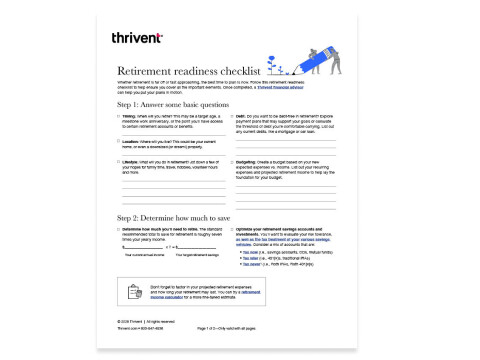Your 60s can be an exciting time. You may be nearing the end of your career and preparing to enjoy the well-earned fruits of your hard work in retirement. Or you might be planning to work beyond conventional retirement age, either in your current job or a new dream job. Whatever you've mapped out for your retirement journey, you may be wondering if you've saved enough to cover your lifestyle. Read on for guidance on how much to save for retirement in your 60s and how to boost your contributions in the upcoming years.
Gauging your retirement savings in your 60s
Many financial advisors suggest a guideline of having eight times your current annual pay saved by your early 60s if you're planning to retire in your mid- to late 60s and aren't expecting to receive a pension.
If you earn $75,000 a year, that means you would need roughly $600,000 in retirement savings by your 60th birthday.
However, identifying your target retirement figure depends largely on your future spending plans. If you think you'll significantly decrease your expenses in retirement—by downsizing or moving to a less-expensive area, for example—you may be able to have less than the general guideline. But if you plan to spend more in retirement by traveling or pursuing expensive hobbies, you should increase your retirement savings target accordingly.
What's average for retirement savings in your 60s?
If you're coming up short of the 8x target, you're not alone. The Federal Reserve shows that adults aged 55–64 have a
When factoring in debt, the average person aged 55–64 has a median net wealth of $364,270.
Think about two things as you compare what you have to guidelines and averages: Your financial situation may be different, and even if you are behind, you still have time to take action and catch up.
For example, the guideline presumes that you're contributing 15% of your earnings to retirement accounts until the day you retire. It also assumes your
You may be contributing more or less, or you may have a different portfolio mix, and that may be OK because you may have different retirement needs and goals than the "average" person.
Let's take a look at how to personalize your retirement savings outlook.
How to decide how much to have saved by your 60s
Your
Here are four questions to ask as you estimate how much retirement savings to have in your 60s:
1. When will you retire?
The recommendation of eight times your salary assumes you're retiring in your mid- to late 60s. If you plan to retire earlier, you'll need more savings—and the difference can be dramatic.
For one, you'll have fewer years to build up your nest egg if you leave the workforce early. Assuming good health, you'll also be withdrawing from your accounts for a longer time. Of course, the opposite is true if you decide to work longer.
A
2. What kind of lifestyle do you want?
Do you dream about traveling extensively or taking up new hobbies? If so, you may need to increase your savings amount.
Creating a post-retirement budget is one of the best ways to estimate your target savings amount. Some expenses may go down as you get older. You won't have commuting costs and may have paid off your loans. But you'll want to add in any new expenditures you'll incur, like those pastimes you hope to enjoy or any new charitable donations.
3. Where do you want to live?
If you plan to move after you retire, be sure to research the cost of living where you plan to live. Are you looking to buy a two-bedroom townhouse in a specific city? Research how much they cost in today's market and make adjustments for inflation. Doing some research now will give you a much more accurate retirement budget to work from.
Don't forget to factor in the local tax treatment of your traditional 401(k) or IRA withdrawals. Several states—including Texas, Florida and Nevada—don't have an income tax. But if you plan to live in a relatively high-tax state like California or New York, your retirement dollars won't go quite as far.
4. How much debt will you carry into retirement?
Review the debt payments you have built into your retirement now. Will you still have them when you shift to not having a full-time income? Most likely, you'll have at least some. Experian data indicates the
For most adults, a home loan is the biggest source of debt by a wide margin, and there are pros and cons to



How to calculate your retirement income in your 60s
Once you have a clear picture of your ideal retirement, you'll need to consider ways to ensure you have enough income to cover your expenses. Estimating what you'll have coming in each month can give you confidence that you'll be able to retire comfortably—or give you the opportunity to adjust now to increase your savings.
Consider the following sources of retirement income, and then use a
Find out how much Social Security you will get
You're eligible to
Calculate your total savings in retirement accounts
Common retirement savings plans like
In addition, you may have other brokerage accounts that can help support you when you leave the workforce. Also be sure to include other assets, such as bank accounts and savings bonds, that you can draw from when you retire. But you'll want to factor in the tax treatment of these funds, as the IRS can take a bite out of your withdrawals.
Check into potential pension income
Some people might have
Consider using cash-value life insurance
The primary purpose of life insurance is death benefit protection, but you can use permanent insurance in other ways. If you no longer need the full amount of death benefit protection, you could opt to receive payments from the contract's cash value to supplement your other income sources. And a portion of those payments potentially would be tax-free.
Assess your home equity & other assets
By the time you retire, the equity in your home can be a significant source of potential income. You have different ways to turn that equity into cash, such as selling your home to downsize. You also can generate income while staying put. At age 62, for example, you may be eligible to take out a reverse mortgage. However, you may want to consult with your financial advisor to determine what options are right for you.
How taxes impact your retirement savings in your 60s
In the
Many of your retirement income sources will be taxed once you start withdrawing the money in retirement. Even
Tax now accounts are ones in which you've paid taxes upfront. These types of accounts typically are suited for current or short-term needs. Examples of tax now accounts include checking accounts, savings accounts and mutual funds.Tax later or tax-deferred assets are ones where your tax liability comes when you withdraw funds. Tax later assets are generally earmarked for longer-term needs like college and retirement. Examples of tax later accounts include 401(k)s, traditional IRAs, variable annuities and fixed annuities.Tax never or tax-free assets generally offer income tax-free treatment on the accumulated value and distribution of funds. Examples include Roth IRAs, Roth 401(k)s, health savings accounts and life insurance.
If you're behind on your savings goals, it's probably a good time to boost contributions to your tax later and tax never accounts—whether through a workplace plan or an IRA. While assets that are taxed now can be helpful for short-term needs, retirement accounts can help reduce your overall tax liability.
You also should incorporate
Ways to boost retirement savings in your 60s
Many people feel uncertain about how prepared they are for retirement. According to the Thrivent Retirement Readiness survey, only 5% of near-retirees said they have everything planned out and are fully ready for retirement. And 44% say they've done only minimal planning. But it's not too late. Here are some great ways to catch up on your retirement savings and renew your commitment to your retirement goals.
Take advantage of catch-up contributions
As you get older, one of the best tools at your disposal is
Since the
For IRAs, the catch-up provision is a little more straightforward. If you're age 50 or older, you can invest an additional $1,100 per year, bringing the total contribution limit to $8,600.
| Plan type | Contribution limit if age 50 or older (2026 tax year) |
| Large employer-sponsored retirement plans: 401(k), 403(b), 457(b), Thrift Savings Plan (TSP) and SARSEP | $32,500 ($35,750 if age 60–63) |
Small business retirement plans: SIMPLE 401(k), SIMPLE IRA SEP IRA | $21,000 ($22,250 if age 60–63) 25% of compensation (employer funded only) |
| Individual retirement accounts: Traditional IRA, Roth IRA | $8,600 |
Consider if a Roth IRA conversion makes sense
A
Roth conversions can be a great way to build tax diversification into your retirement savings. Ideally, you want the time when you owe taxes on your different accounts to vary so your tax burden isn't too great at one period of time.
Find ways to decrease your expenses
During the last few years of your career, you might want to consider what expenses you could trim from your budget. Simple things like canceling gym memberships and subscriptions, dining out less or taking public transit more could help increase your retirement savings.
You also can use this time to try out your retirement lifestyle. If you want to downsize to a smaller house, why not move a little earlier? The amount you save on utilities, property taxes and other expenses could go a long way toward slowing down your cash outlay.
Weigh the advantages of delaying retirement
If you're behind on your original investment goals, you might consider putting off retirement. Each extra year you earn a paycheck is another year you can put money aside and not draw down your savings. It's also a chance to delay Social Security to increase your eventual payout—until you
Increase your earnings with part-time or gig work
Even when you're no longer working full time, there may be opportunities to generate some extra income from part-time employment or even

Protecting your retirement savings from risk
With factors from economic volatility to health issues, retirement is never predictable. By the time you reach your 60s, it's smart to account for the risks to the savings you've worked hard to put into place.
Adopting the right strategies helps ensure you can weather any storms on the horizon. For example:
- Build some hedges against high tax rates and inflation, which can throw you a curveball when you're anticipating a fixed income.
- Explore solutions that guarantee you don't outlive your money.
- Adjust your risk tolerance to shield against market volatility.
- Protect against the real risk of a health care event draining your savings.
Journey toward your retirement with confidence
Whatever you see for yourself in retirement, you want to be confident that you'll have the means to sustain that vision. By setting clear goals, saving effectively and budgeting, you can build a secure future and get the most out of this exciting next stage of life.
Looking for an expert to help guide you? Consider meeting with a







